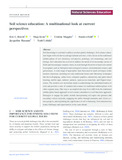JavaScript is disabled for your browser. Some features of this site may not work without it.
| dc.contributor.author | Brevik, Eric C. | |
| dc.contributor.author | Krzic, Maja | |
| dc.contributor.author | Muggler, Cristine | |
| dc.contributor.author | Field, Damien | |
| dc.contributor.author | Hannam, Jacqueline | |
| dc.contributor.author | Uchida, Yoshi | |
| dc.date.accessioned | 2022-05-13T13:47:05Z | |
| dc.date.available | 2022-05-13T13:47:05Z | |
| dc.date.issued | 2022-03-16 | |
| dc.identifier.citation | Brevik EC, Krzic M, Muggler C, et al., (2022) Soil science education – a multi-national look at current perspectives, Natural Sciences Education, Volume 51, Issue 1, May 2022, Article number e20077 | en_UK |
| dc.identifier.issn | 2168-8273 | |
| dc.identifier.uri | https://doi.org/10.1002/nse2.20077 | |
| dc.identifier.uri | http://dspace.lib.cranfield.ac.uk/handle/1826/17893 | |
| dc.description.abstract | Soil knowledge is essential to address modern global challenges. Soil science education began with soil survey and agricultural activities, with a focus on the traditional subdisciplines of soil chemistry, soil physics, pedology, soil mineralogy, and soil biology. Soil education has evolved to address the needs of an increasing variety of fields and increasingly complex issues, as seen through the move to teach soil content in programs such as biological and ecological sciences, environmental science, and geosciences. A wide range of approaches have been used to teach soil topics in the modern classroom, including not only traditional lecture and laboratory techniques but also soil judging, online tools, computer graphics, animations, and game-based learning, mobile apps, industry partners, open-access materials, and flipped classrooms. The modern soil curriculum needs to acknowledge the multifunctionality of soils and provide a suite of conduits that connect its traditional subdisciplines with other cognate areas. One way to accomplish this may be to shift from the traditional subdiscipline-based approach to soil science education to a soil functions approach. Strategies to engage the public include incorporating soil topics into primary and secondary school curricula, engaging the public through museums and citizen science projects, and explaining the significance of soil to humanity. Soil education has many challenges and opportunities in the years ahead. | en_UK |
| dc.language.iso | en | en_UK |
| dc.publisher | Wiley | en_UK |
| dc.rights | Attribution-NonCommercial-NoDerivatives 4.0 International | * |
| dc.rights.uri | http://creativecommons.org/licenses/by-nc-nd/4.0/ | * |
| dc.subject | global challenges | en_UK |
| dc.subject | soil functions | en_UK |
| dc.subject | multifunctionality of soils | en_UK |
| dc.subject | education strategies | en_UK |
| dc.title | Soil science education – a multi-national look at current perspectives | en_UK |
| dc.type | Article | en_UK |
| dc.identifier.eissn | 2168-8281 |
Files in this item
The following license files are associated with this item:
This item appears in the following Collection(s)
-
Staff publications (SWEE) [2803]

